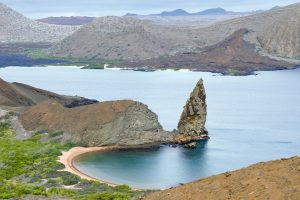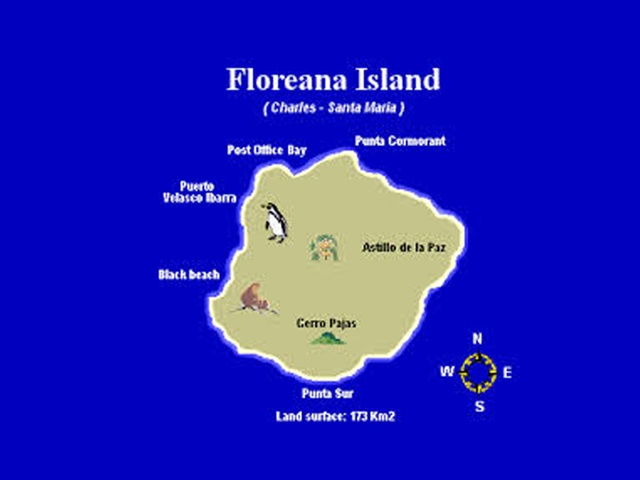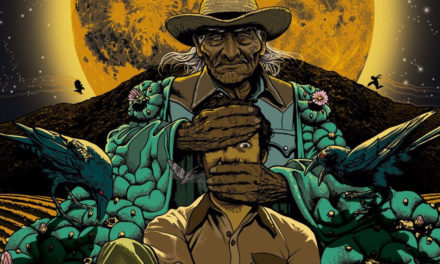The Galapagos Affair
There are a few places on earth that can be called the Middle of Nowhere, and the Galapagos Islands qualify. Only 600 miles west of Ecuador and the South American Coast, the islands have a long history of standing apart from civilization. Charles Darwin discovered that life there had taken a different path in evolution, so removed were its flora and fauna from the rest of the world.
 The islands may appear to be a paradise of the warm, equatorial variety. But most are virtually uninhabitable by humans, at least uninhabited until recently. So who should care that a few eccentric Europeans, in the 1930’s, decided against the odds to settle on the rocky, remote outpost of Floreana?
The islands may appear to be a paradise of the warm, equatorial variety. But most are virtually uninhabitable by humans, at least uninhabited until recently. So who should care that a few eccentric Europeans, in the 1930’s, decided against the odds to settle on the rocky, remote outpost of Floreana?
But the very rare, isolated nature of their adventure attracted worldwide attention. Then, when two of the colonists disappeared, perhaps murdered by others, The Galapagos Affair was born. No bodies, or fully transparent explanations for the disappearances, have ever emerged, not in all the years, and all the books.
Come join us for an adventure where Robinson Crusoe meets Sherlock Holmes, and learn with us about The Galapagos Affair.
TRUTH IS ALWAYS STRANGER THAN FICTION
It was the 1930s. A handful of Germans pack up their lives and move to one of the most remote places in the world — the Galapagos archipelago. They settle on one of the most remote islands — Floreana.
They wanted to live like pioneers. But their story takes a turn when two of the islanders disappear under suspicious circumstances.
A new film, “The Galapagos Affair: Satan Came to Eden,” chronicles the tale of how these unlikely pioneers ended up on Floreana and the mysterious disappearances that followed.
The filmmakers came upon the murder mystery while aboard a boat working on a nature documentary on the Galapagos.
“We’d gone down
to the Galapagos assuming there were no human inhabitants and it was really just a place devoted to tortoises and Darwin’s finches and iguanas,” said filmmaker Dayna Goldfine. “Much to my surprise, I pulled this book off the shelf and it was about the human history of the islands.”
Goldfine was surprised to discover a chapter devoted to a murder mystery.
But it wasn’t until years later the filmmakers found 16 mm film footage at the University of Southern California that told the tale of Floreana Island.
“That was the key to unlocking this whole movie because we didn’t know that footage was there for the first couple of years we were mulling over what to do, if there was a way to make the movie,” said filmmaker Dan Geller.
Once they had the archives, the filmmakers pieced together what happened to the settlers.
Next, Goldfine and Geller hired actors to be the voices of the characters.
The impressive cast includes Cate Blanchett and Diane Kruger.
April 4, 2014, pri.org
The documentary does cover a lot of ground, and is worth seeing for hardcore mystery buffs, but this amazing story may be best captured through written legend, and the richness of the human imagination.
To start, consider:
Each of the European settlers who came to Floreana in that era had to be quite a piece of work–who with a normal personality would try to live permanently on an island with little to sustain life, only hardship?
That’s the first level of mystery. What drives some people, who always seemed more or less “normal” as they lived in their native communities, to step entirely outside society?
Can a professional psychologist predict who will make such a leap? We doubt it.
Out of all the millions, four adults from high civilization, then finally seven, decide to try to survive on a harsh tropical island.
(Warning: food does Not just drop off of coconut trees on warm islands, they can be as forbidding in their way as the Arctic.)
And ultimately, one of the last arrived was a sociopath, a woman about as welcome in cooperative living under difficult circumstances as the snake would be in the mouse’s nest. She was utterly unsuited to the human needs of the environment–Mother Teresa would have tried to strangle her, no doubt.
A story as compelling as a real world Lord of the Flies. Read on.
FLOREANA ISLAND… AND SEVERAL CRAZY EUROPEANS
The Galapagos Islands are best known for their giant tortoises, but they’re also the site of one of the most bizarre homesteading misadventures ever, complete with proto-hippies, a polyamorous baroness, potentially poisoned boiled chicken, births in pirate caves, and unsolved deaths that look a lot like murder.
Floreana, a small island in the Galapagos archipelago, currently has a population of around 100 people, including direct descendants of the island’s original German expat settlers.
Charles Darwin popped by Floreana in 1835, and the small island’s desolate bay served as a makeshift post office for merchants and pirates before and after the HMS Beagle came to visit. Norwegian sailors built a house for shelter there and then abandoned it, and buccaneers hid out in the caves beyond the island’s spiky lava fields. However, it was the island’s first batch of wannabe permanent settlers who left Floreana with its most notorious legacy.
In 1928, a German couple named Dr. Frederick Ritter and Dore Strauch showed up with a plan to create a utopia for two.
It did not go well.
Strauch wrote a memoir about her life on the island, and it’s like Into the Wild written by an old-timey German lady with Stockholm syndrome. She met Ritter, a doctor fifteen years her senior, when he treated her for multiple sclerosis. They bonded over their shared hatred of bourgeois domesticity.
Ritter was a sort of reverse Henry Higgins for Strauch, pushing her to change from a bored city wife into a stateless, toothless hermit. He told her she could overcome her physical ailments through sheer willpower, she believed him, and they left their respective spouses and families to move from Germany to Floreana.
He also held, uh, unorthodox views for a doctor. Ritter preemptively removed his teeth before the trip because he wanted to see if his gums would toughen up in the wilderness. He didn’t bother arranging for Strauch to get her teeth removed, nor did he bring any dentistry tools, so her teeth rotted and had to be yanked out with gardening supplies while they were on the island. Then they shared the one pair of DIY stainless steel false teeth Ritter had made. They also didn’t wear many clothes.
Their only visitors were boats passing through Post Office Bay. Some of those boats contained people who told the press about the island’s often-naked settlers. They became minor celebrities from thousands of miles away when the papers published stories of the back-to-nature couple, characterizing them a modern-day Adam and Eve.
Their newfound fame blew up their spot. Heinz and Margret Wittmer, another couple from Germany, read about the Ritters in the newspaper and decided that they, too, would shirk the modern world in favor of island life with their child, a preteen named Harry, in tow. Margret was pregnant, and they moved with the hope that Ritter would help her deliver their second baby and generally be their bud, not realizing that he was a deluded dickhead.
Gizmodo.com, 11/20/15
Above, an excerpt from a very gifted young Gizmodo writer. You have to forgive her for the last word of the last paragraph quoted, it makes her sound less professional than she really is, it seems she was quite animated by her task.
And what a story it is to sink one’s teeth into!
Even reading the book-length treatments of the adventure, full of usually-dull-detail about fauna and flora and survival, engages some very primal senses….simply: these Europeans really were modern day Robinson Crusoes. And the stories convey the remoteness of the location, in it’s way really as remote as the North or South Poles, just absolutely the middle of nowhere. (Floreana had been uninhabited, mostly, for centuries, although the Ecuadorians were quite aware of all the islands under their territorial control.)
You were on your own there. No point in asking for product delivery from Amazon.
The four Germans that scraped a life out of the island would have been interesting enough as a desert island tale a la Daniel Defoe, but they were joined by three others.
The next section hints, at least, at the jaw-dropping personality of the “Baroness” who arrived with two male admirers, although all three were dead within a couple of years.
The names matter little, but one Eloise Bosquet de Wagner Wehrhorn was the one who called herself the “Baroness,” although sometimes, believe it or not, it was “Empress.” From Austrian aristocracy, supposedly. Robert Phillipson, her reasonably handsome main lover, and tag-a-long Rudolf Lorenz constituted her mini-harem and loyal servants, when Ecuadorians were not available to the Islands, or even if they were.
Imagine yourself as the serious Wittmers, or Stauch or Ritter for that matter, and think of what this intrusion on Floreana would have seemed like. She wanted to take over the place, build a tourist hotel of all things, and rule like an empress, of course.
Is your primary beef her enormous aires and pretensions, lack of work ethic, habit of stealing everything, or a personality which is clearly narcissistic but probably disturbed, and sometimes violent, as well?
Take your pick.
THE AMAZING DISAPPEARANCE OF A DERANGED WOMAN
Strauch had been enthralled by Ritter’s Nietzschean philosophical principles and his advocacy of a natural life, a vegetarian diet and an idyllic Pacific Island existence. The reality was that his behavior often marked him as a bully and a hypocrite. He was rude to visitors, abused Dore and while refusing her simple pleasures such as coffee on the basis of his philosophical principles, was not averse to having a good beefsteak or ham hock from time to time despite his avowed vegetarianism.They called their utopia “Friedo.”
Ritter was less than delighted when three years later Heinz Wittmer and his pregnant wife Margret, a pair of practical German burghers, settled on the island. Accompanying them was Harry, Heinz’s son by a previous marriage, whose fragile health had prompted them to seek sunshine and fresh air in the tropics.
Shortly afterwards, Ritter was even less impressed when the self-proclaimed Baroness Wagner de Bosquet arrived with two lovers and an Ecuadorean laborer in tow. A dramatic, flamboyant and often ill-tempered woman, she totally dominated her two lovers, handsome though weak-willed young men who seemed terrified of her. Her stated intention was to open a luxury hotel on the island for American millionaires, to be called Hacienda Paradiso.
The grandiose Baroness soon acclaimed herself Empress of Floreana and appeared not averse to appropriating property of the other island residents as well as opening their mail. She sported a riding crop and an ivory handled pistol which she was fond of pointing at people who displeased her. She soon had the Wittmers as well as Friedrich and Dore very nervous of her and her armed entourage.
The Baroness could be very charming and became something of an international celebrity, much to Ritter’s distress as he had previously had the press limelight as the “Robinson Crusoe” of Floreana. Wealthy yacht owners would call and often leave gifts for her and the other residents, though these gifts, including several cases of canned milk destined for the Wittmer’s new baby, Rolf, seemed to have been diverted to the Baroness’s use.
Subsequently the governor of the Galapagos paid an official visit to Floriana. Even he proved susceptible to the Baroness’s charms, granting her four square miles of territory for her proposed hotel, but only 50 acres each to the Wittmers and to Ritter and Dore. The Baroness later spent several weeks as the governor’s guest at his home on Chatham Island.
The Baroness appears to have suffered from what we would now call a borderline personality disorder with strong sociopathic tendencies. By her own admission she liked to shoot animals in the legs so that she could have the pleasure of nursing them back to health. An advocate of free love she often added more male admirers to her harem. She eventually overstepped her bounds and ended up shooting her current favorite in the stomach while trying to “accidentally” wound a new prospective lover named Boeckmann in the leg, apparently hoping her favored technique would work on human beings as well as animals. In this case the quarry escaped.
In keeping with a borderline personality disorder, the Baroness could turn from charming to vicious over any real or imagined slight. Her former favorite Rudolf Lorenz, who became literally her slave and whipping boy, and who used to do all the difficult labor at Hacienda Paradiso, was barely fed enough to survive. One of her current favorites, Phillippson, beat Lorenz regularly.
The island’s other residents, in the meantime, had become even more terrified of the Baroness and Lorenz was absolutely desperate. John Treherne, in his book The Galapagos Affair, describes how Lorenz fled to live with the Wittmers and believes the Baroness attempted to lure him into a trap by telling Margret Wittmer that she and Phillippson would be leaving the island aboard a visiting yacht bound for Tahiti. No record of any such yacht was ever discovered but the Baroness and Phillippson nevertheless disappeared in March, 1934. Left behind were their luggage and most precious possessions.
No bodies were ever found and their ultimate fate has never been determined. Treherne explored various possibilities and the evidence suggests that Lorenz, with Ritter’s assistance, poisoned or shot the Baroness and Phillippson, then hid their remains.
Postscript: Dore left the island the following year aboard the yacht of Captain Hancock. Lorenz departed the island aboard a fishing vessel belonging to a Norwegian named Nuggerud. Their vessel disappeared and later the mummified corpses of the two men were found on a beach on the island of Marchena, well north of Floreana, dead of dehydration.
While all the others perished, departed or both, the resilient and resourceful Wittmers continued to flourish. They still populate the island, with matriarch Margret Wittmer only passing away in the year 2000 at the age of 95, surrounded by her descendants and still refusing to divulge any additional secrets that might shed further light on the Galapagos Affair.
lifeasahuman.com” Feb. 24, 2014
A fellow named George Burden, who has studies these matters extensively, does a good job here at showing how four Europeans suddenly became seven, with the small, delicate local fabric immediately strained and fraying, and soon burning up.
Much centers on this phony, but oh so real “Baroness,” may she rest in peace (or burn in hell, depending on point of view).
She would intercept your mail, even your food stores arriving by ship, pretend they were hers, and offer to sell them back to you.
She would take over the spring sources you had discovered, saying she had discovered them.
She would shoot animals in the leg, to later have the satisfaction of nursing them back to health. She even did this at least once on the island, it’s said, with a visiting human.
She would threaten anyone with a gun who she thought needed threatening.
To a delicate “ship of survival,” was she simply a hole in the bottom of the boat?
Borderline personality disorder, narcissism, sociopathy? Can we diagnose at such a distance of time and space?
THE FLOREANA ISLAND MURDERS, YOUR TAKE?
A ship had come through, quickly and unexpectedly, and offered the Baroness passage to the South Pacific, and she’d quickly decided to go, taking Phillipson with her, but ditching Lorenz. So decisive a change that she bequeathed her left-behind belongings to Lorenz, to do with as he pleased.
(The remaining islanders seem to have absorbed those items, among themselves, without much delay.)
In some versions Lorenz and Margaret Wittmer came to the Ritters with the story.
In any event, no one really believes the Baroness left on a ship, abruptly. Ships were usually spotted by all the others on the island, or known about in the region. No one ever heard or saw trace of the Baroness, or Phillipson, again.
A dinner murder mystery, anyone?
Before we, at MindOverMystery, opine further over what ultimately happened on Floreana, and what it means, we’d like to hear from readers who’ve taken time to study up on this remarkable passage in Galapagos history.
What happened, say you, to the disappeared Baroness and her main paramour?
What should have happened? How different should the rules be in a fully different society, seven people trying to survive on lava rocks in the middle of nowhere?




